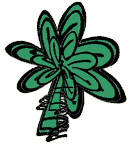|

Rubber is a sticky, elastic solid produced from a milky liquid called "latex," which has different properties than thesapfound in trees. Although latex is found in the bark, roots, and stems, branches, leaves, and fruit of over 400 different plants and trees, the bulk is found, andextracted, from the inner bark of the branches, and from the trunk, of the rubber tree. Quite simply, it would not be cost-effective to extract the latex from rubber producing plants, such as thedandelion, themilkweed, and thesagebrush. Just visualize some poor soul laboring over one of these with asyringe!
Rubber, derived from thegumof a tree, has existed sinceprehistorictimes. For example, fossils of rubber-producing plants date back almost 3,000,000 years.Crude rubberballs, discovered in ruins of ancientIncan and Mayan civilizationsin Central and in South America, are, at very least, 900 years old. Natives of Southeastern Asia used rubber, prepared from the "juice" of trees to waterproof their baskets and jars. Even Columbus, on his second voyage to the New World, observed Haitian natives playing with balls made from "the gum of a tree."
Latex consists of tiny particles of liquid, solid, orsemi-fluidmaterial, that appears in the form of a watery liquor, not to be drunk! Thebreakdownon this watery liquid is only about 33% rubber, with the remainder being, not surprisingly, water! When the rubber particles in the latex join together, they form a ball of rubber.
Rubber producing plants grow best within 10 degrees of the Equator, where the climate is hot and moist, and the soil is deep and rich. For this reason, the area of about 700 miles on each side of the Equator is known as the "Rubber Belt." Brazil, from whence the best, and top-producing rubber tree hails, is firmly planted within the Rubber Belt. This Latino tree with a Latin name,Hevea brasiliensis, produces approximately 96% of the world's supply of natural rubber, and now is cultivated in other Rubber Belt countries.
Most likely, the French, prior to the 1800s, were the first white men to take advantage of rubbers' elasticity. They manufactured "rubber bands" for use with their garters and their suspenders, to help to keep their pants up. Rubber belts did not exist at that time.
|
|
note:
|
latex: 胶乳,乳液
sap: 树液,汁液
extract: 提取
dandelion: 蒲公英
milkweed: 乳草属植物
sagebrush: 山艾树
gum: 树胶
crude rubber: 天然橡胶
Incan and Mayan civilizations: 印加和玛雅文化
semi-fluid: 半流体
breakdown: 分解
Hevea brasiliensis: 橡胶树
|
|